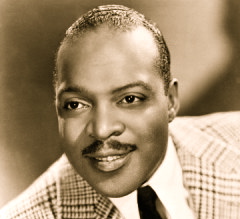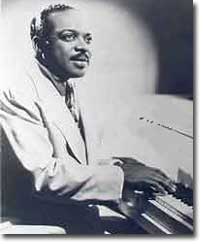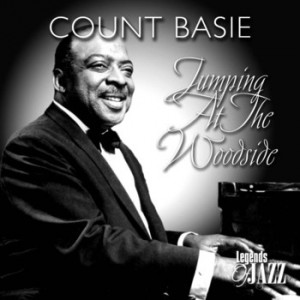Count Basie

Count Basie and his Orchestra (1965)
 William “Count” Basie (August 21, 1904 – April 26, 1984 was an American jazz pianist,organist, bandleader, and composer. His mother first taught him piano and he started performing in his teens. Dropping out of school, he learned to operate lights for vaudeville and improvised to accompany silent films at a local theater in his town of Red Bank, New Jersey. By 16, he increasingly played jazz piano at parties, resorts and other venues. In 1924, he went to Harlem, where his performing career expanded; he toured with groups to the major jazz cities of Chicago, St. Louis and Kansas City. In 1929 he joined Bennie Moten‘s band in Kansas City, and played with them for years, until Moten’s death in 1935.
William “Count” Basie (August 21, 1904 – April 26, 1984 was an American jazz pianist,organist, bandleader, and composer. His mother first taught him piano and he started performing in his teens. Dropping out of school, he learned to operate lights for vaudeville and improvised to accompany silent films at a local theater in his town of Red Bank, New Jersey. By 16, he increasingly played jazz piano at parties, resorts and other venues. In 1924, he went to Harlem, where his performing career expanded; he toured with groups to the major jazz cities of Chicago, St. Louis and Kansas City. In 1929 he joined Bennie Moten‘s band in Kansas City, and played with them for years, until Moten’s death in 1935.
That year Basie formed his own jazz orchestra, and in 1936 took them to Chicago for a long engagement and their first recording. He led the group for almost 50 years, creating innovations like the use of two “split” tenor saxophones, emphasizing the rhythm section, riffing with a big band, using arrangers to broaden their sound, and others. Many notable musicians came to prominence under his direction, including the tenor saxophonists Lester Young and Herschel Evans, the guitarist Freddie Green, trumpeters Buck Clayton and Harry “Sweets” Edison and singers Jimmy Rushing and Joe Williams. Basie’s theme songs were “One O’Clock Jump,” developed in 1935 in the early days of his band, and “April In Paris.”
Early Life and Education
 William Basie was born to Harvey Lee and Lillian Basie in Red Bank, New Jersey. His father worked as a coachman and caretaker for a wealthy judge. After automobiles replaced horses, his father became a groundskeeper and handyman for several wealthy families in the area. His mother, a piano player who gave Basie his first piano lessons, took in laundry and baked cakes for sale. She paid 25 cents a lesson for piano instruction for him.
William Basie was born to Harvey Lee and Lillian Basie in Red Bank, New Jersey. His father worked as a coachman and caretaker for a wealthy judge. After automobiles replaced horses, his father became a groundskeeper and handyman for several wealthy families in the area. His mother, a piano player who gave Basie his first piano lessons, took in laundry and baked cakes for sale. She paid 25 cents a lesson for piano instruction for him.
Not much of a student in school, Basie dreamed of a traveling life, inspired by touring carnivals which came to town. He finished junior high school but spent much of his time at the Palace Theater in Red Bank, where doing occasional chores gained him free admission to performances. He learned to operate the spotlights for the vaudeville shows. One day, when the pianist failed to arrive by show time, Basie took his place. Playing by ear, he quickly learned to improvise music appropriate to the acts and the silent movies.
http://www.jazzvideoguy.tv presents the immortal Count Basie featuring Clark Terry on trumpet, Wardell Gray- tenor sax, Buddy DeFranco-clarinet, Freddie Green-guitar, Jimmy Lewis-bass and Gus Johnson-drums. In between Big Bands in the mid-50s, Basie led this smaller group. This excerpt is from a film that is now in public domain called “Rhythm and Blues Review.” You can download it from http://www.archive.org
 Though a natural at the piano, Basie preferred drums. Discouraged by the obvious talents of Sonny Greer, who also lived in Red Bank and became Duke Ellington‘s drummer in 1919, Basie at age 15 switched to piano exclusively. Greer and Basie played together in venues until Greer set out on his professional career. By then, Basie was playing with pick-up groups for dances, resorts, and amateur shows, including Harry Richardson’s “Kings of Syncopation.” When not playing a gig, he hung out at the local pool hall with other musicians, where he picked up on upcoming play dates and gossip. He got some jobs in Asbury Park at the Jersey Shore, and played at the Hong Kong Inn until a better player took his place.
Though a natural at the piano, Basie preferred drums. Discouraged by the obvious talents of Sonny Greer, who also lived in Red Bank and became Duke Ellington‘s drummer in 1919, Basie at age 15 switched to piano exclusively. Greer and Basie played together in venues until Greer set out on his professional career. By then, Basie was playing with pick-up groups for dances, resorts, and amateur shows, including Harry Richardson’s “Kings of Syncopation.” When not playing a gig, he hung out at the local pool hall with other musicians, where he picked up on upcoming play dates and gossip. He got some jobs in Asbury Park at the Jersey Shore, and played at the Hong Kong Inn until a better player took his place.

